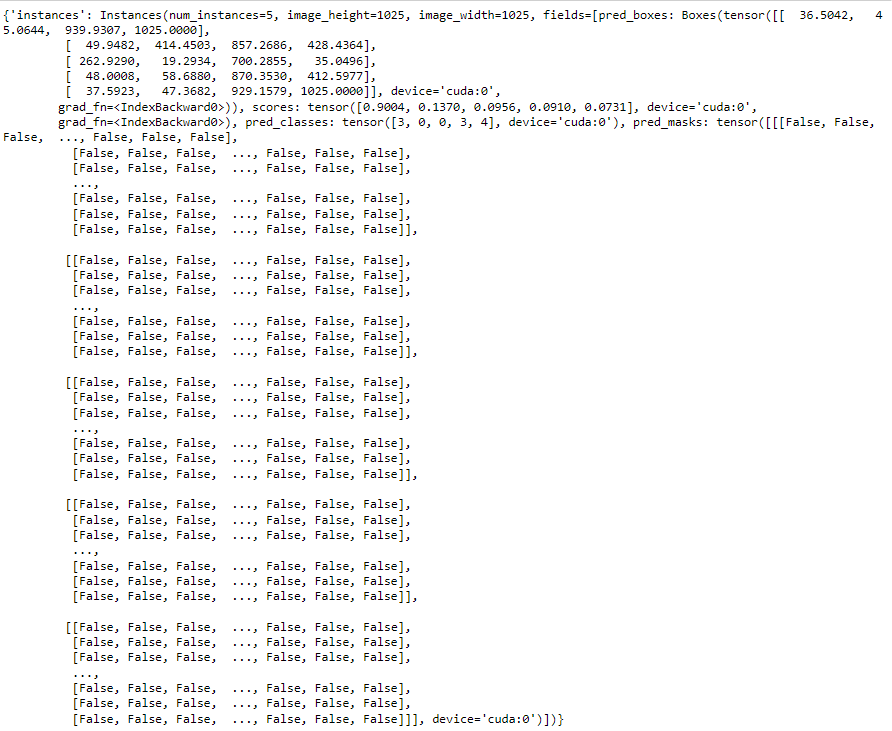Hi all,
So, based on an existing implementation, I am trying to adapt it to my goal by changing the loss calculation, which is giving None for every grad after backward step.
I believe the graph might be broken, based on similar topics I have read, but I am also in doubt if it has to do with the loss and the way the backward is done.
The model output is the following:
It also returns several losses in a dictionary (dict_loss).
However I want to use crossentropyloss based on each bounding box. As example an image with 15 bounding boxes, each one with one label, and this is what I am using as target in the loss calculation (a tensor of 15 labels).
In order to have the tensor with the class probabilities for each bounding box from the model outputs, I wrote two functions. The first, takes the pred_boxes, pred_classes and scores and builds pred_masks.
The pred_masks have as shape (batch_size, n_classes, height, with).
def get_pred_mask(self, outputs, n_classes, mask_shape):
final_masks = []
for ioutputs in outputs:
pred_mask_cl = [np.zeros((mask_shape[0], mask_shape[1])) for icat in range(0,n_classes+1)]
for icl in range(0, len(ioutputs['instances'].pred_classes)):
for icat in range(0,n_classes):
if ioutputs['instances'].pred_classes[icl]==icat:
coord = ioutputs['instances'].pred_boxes[icl].tensor
class_coord = (int(coord[0][0]), int(coord[0][1])), (int(coord[0][0]+coord[0][2]), int(coord[0][1]+coord[0][3]))
color = int(ioutputs['instances'].pred_classes[icl])
pred_mask_cl[icat+1] = cv2.rectangle(pred_mask_cl[icat+1], class_coord[0], class_coord[1], color, -1)
final_masks.append(pred_mask_cl)
return torch.tensor(np.stack(final_masks), requires_grad=True, device='cuda')
Then I take this output and use it to get the class probabilities for each bounding box, I go and get the most common class for each bounding box to consider.
def get_bbox_label(self, y_t, bbox_to_consider, n_classes, first_class=1, original_shape=(1025,1025)): #batch[0]['image'].shape[1:]):
softmax=nn.Softmax(dim=1)
y_score=y_t
y_=y_t.argmax(1)
final_labels = []
scale = y_[0].shape[0]/original_shape[0]
for i in range(0,len(y_)):
img_id=str(uuid.uuid4())
bbox_group_all=[]
bbox_group_score_all=[]
for ixb in bbox_to_consider[i]:
class_coord = ((int(ixb[0]*scale), int(ixb[1]*scale)), (int(ixb[2]*scale), int(ixb[3]*scale)))
bbox_group = y_[i][int(ixb[1]*scale):int(ixb[3]*scale), int(ixb[0]*scale):int(ixb[2]*scale)]
bbox_group_score = y_score[i][first_class:,int(ixb[1]*scale):int(ixb[3]*scale), int(ixb[0]*scale):int(ixb[2]*scale)]
bbox_group = Counter(bbox_group.reshape(bbox_group.shape[0]*bbox_group.shape[1]).tolist()).most_common(1)[0][0]
bbox_group_score = bbox_group_score.reshape(bbox_group_score.shape[0], bbox_group_score.shape[1]*bbox_group_score.shape[2])
bbox_group_all.append(bbox_group if bbox_group!=0 else 1) #force that if no label it is text
bbox_group_score_all.append([np.round(i.item(),2) for i in bbox_group_score.max(1).values.reshape(1, n_classes)[0]])
final_labels.append(pd.DataFrame({'bbox_label': [bbox_group_all], 'bbox_group_score': [bbox_group_score_all], 'img': img_id}))
final_labels = pd.concat(final_labels).reset_index(drop=True)
pred_label_bbox = torch.tensor(np.concatenate([item for sublist in final_labels.bbox_group_score.tolist() for item in sublist]).reshape(50,5), requires_grad=True, device='cuda')
return(pred_label_bbox)
Finally, I calculate the loss (both tensors used in this calculation are leaf tensors):
c_losses = loss_fn(pred_label_bbox.reshape(len(target), n_classes), target)
The logic that follows is:
grad_scaler = GradScaler()
(...)
grad_scaler.scale(c_losses).backward()
grad_scaler.step(optimizer)
grad_scaler.update()
Where I get:
File /usr/local/lib/python3.8/dist-packages/torch/cuda/amp/grad_scaler.py:343, in GradScaler.step(self, optimizer, *args, **kwargs)
341 print("debug...")
342 print(optimizer_state["found_inf_per_device"])
--> 343 assert len(optimizer_state["found_inf_per_device"]) > 0, "No inf checks were recorded for this optimizer."
345 retval = self._maybe_opt_step(optimizer, optimizer_state, *args, **kwargs)
347 optimizer_state["stage"] = OptState.STEPPED
AssertionError: No inf checks were recorded for this optimizer.
PROBLEM: And from here I found out the the grads are None!
However, if I use the original implementation loss, everything works well.
The differences I see:
- Original implementation:
sum(dict_loss.values())
> tensor(5.3273, device='cuda:0', grad_fn=<AddBackward0>)
grad_scaler.scale(sum(dict_loss.values()))
> tensor([349132.5312], device='cuda:0', grad_fn=<MulBackward0>)
- Mine:
loss
> tensor(1.7942, device='cuda:0', dtype=torch.float64, grad_fn=<NllLossBackward0>)
grad_scaler.scale(loss)
> tensor([117585.7969], device='cuda:0', grad_fn=<MulBackward0>)
Thank you in advance for your help. Any insight will be much appreciated!
